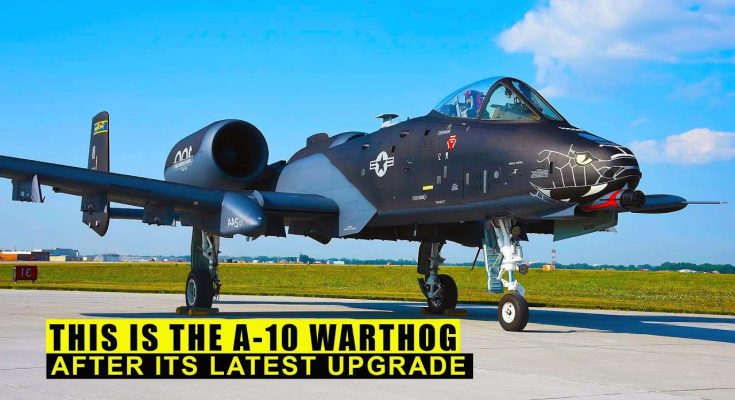This New Upgrade Takes the A-10 Warthog to the Next Level!
The A-10 Thunderbolt II, better known as the A-10 Warthog, has long been a symbol of ruggedness and reliability in the skies, renowned for its unmatched ability to provide close air support (CAS) for ground forces. Despite being in service since the 1970s, the A-10 has continuously evolved, with each upgrade making it more lethal and effective in its role. The latest upgrade for the A-10 is a game-changer, taking this venerable aircraft to a whole new level of capability, ensuring that it remains a dominant force in the U.S. Air Force (USAF) arsenal for years to come.
The Iconic A-10 Warthog
The A-10 Warthog was originally designed in the early 1970s to serve as a dedicated close air support aircraft, primarily for striking ground targets like tanks, armored vehicles, and personnel. Its most iconic feature is the GAU-8/A Avenger cannon, a massive 30mm rotary gun capable of firing up to 3,900 rounds per minute. This weapon alone made the A-10 feared by ground forces, as it could unleash devastating firepower against enemy targets with incredible accuracy. The aircraft’s rugged design, which includes a heavily armored cockpit and wing structure, enables it to survive hits from ground fire and continue the mission.
Despite its age, the A-10 has remained one of the most effective CAS platforms in the world. However, with advancements in enemy air defenses, weapons technology, and operational requirements, the Warthog needed to evolve to meet new challenges.
The Latest Upgrade: Advanced Capabilities
The latest upgrade program for the A-10, dubbed the A-10 Thunderbolt II “Wing Replacement Program” (WRP), is a multi-faceted modernization effort designed to extend the aircraft’s service life and improve its operational effectiveness. Here’s a breakdown of the key enhancements:
1. Enhanced Avionics and Communications Systems
The A-10’s aging avionics and communication systems were updated with state-of-the-art equipment. The new digital cockpit includes improved displays and navigation systems, making it easier for pilots to receive and process real-time information during combat operations. The inclusion of Link 16, a secure communications system used by NATO, allows the A-10 to more effectively share intelligence and coordinate with other friendly forces, including aircraft, ground units, and command centers.
2. Modernized Targeting and Weapons Systems
The upgrade also introduces enhanced targeting pods and precision-guided munitions (PGMs) integration. The A-10 has long been capable of carrying a variety of bombs, rockets, and missiles, but the integration of Laser-Guided Bombs (LGBs), Joint Direct Attack Munitions (JDAMs), and other PGMs allows it to hit targets with greater precision from standoff ranges. Additionally, the improved sensor suite, which includes infrared targeting systems, allows the A-10 to track and engage both stationary and moving targets in a variety of weather conditions, enhancing its effectiveness on the modern battlefield.
3. Wing Replacement and Structural Upgrades
One of the most important aspects of the upgrade is the replacement of the A-10’s aging wings. As the aircraft had been in service for over 40 years, its original wings were starting to show signs of wear. The new wings, constructed from composite materials, significantly extend the aircraft’s service life and reduce maintenance needs. This upgrade allows the A-10 to remain operational for an additional 10-15 years, ensuring its continued dominance in the CAS role.
The new wings also come with improved aerodynamics, which translates to better fuel efficiency, higher payload capacity, and improved maneuverability. This makes the A-10 even more effective in the highly dynamic and fast-moving environments of modern combat.
4. Upgraded Engine and Propulsion System
The A-10’s engines, originally designed in the 1970s, were also given a significant boost. Newer, more efficient TF34 engines are being installed, which not only improve fuel efficiency but also reduce the jet’s operating costs. The upgraded engines provide better thrust and performance, allowing the A-10 to operate more effectively in challenging conditions, such as high-altitude or hot weather environments.
5. Enhanced Survivability Features
Another key focus of the upgrade is improving the A-10’s already impressive survivability. The aircraft has always been designed to withstand significant damage and keep flying, and the new upgrades enhance this ability further. The cockpit armor has been reinforced, and new self-sealing fuel tanks have been added to minimize the risk of catastrophic fuel leaks. Additionally, advanced fire suppression systems have been integrated to reduce the chance of engine fires during combat operations.
Why This Upgrade Is Crucial
The A-10’s continued relevance is essential for close air support, a mission that no other aircraft can replicate as effectively. While jets like the F-35 Lightning II and F-16 Fighting Falcon are multirole aircraft capable of a wide variety of missions, they cannot match the A-10’s low-speed, high-durability, ground-attack focus. The Warthog is unrivaled in its ability to fly slow and low, getting close to enemy positions to deliver devastating firepower while providing close coordination with ground troops.
The upgrades ensure that the A-10 will remain a cornerstone of the USAF’s CAS capabilities, particularly in asymmetric warfare, where the enemy is often utilizing irregular tactics and terrain that require precision and close coordination. With these modern enhancements, the A-10 will remain effective against both conventional military forces and insurgent groups for the foreseeable future.
Conclusion
The new upgrades to the A-10 Warthog are a crucial step in extending the life and enhancing the capabilities of one of the most beloved and effective aircraft in history. With modern avionics, enhanced weapons systems, and structural improvements, the A-10 is now more lethal, efficient, and survivable than ever before. As the Warthog continues to provide unparalleled close air support for ground forces, these upgrades ensure it will remain a key player in U.S. military operations for many years to come. The A-10’s legacy as the ultimate “flying tank” is secure, and its future just became even brighter.



